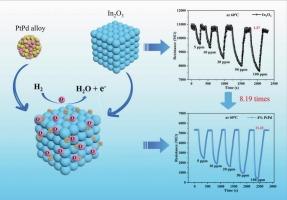PtPd合金增强立方体In2O3用于氢传感:低检测限和降低工作温度
IF 6.9
2区 材料科学
Q2 CHEMISTRY, PHYSICAL
引用次数: 0
摘要
随着全球对清洁能源需求的增加,氢能将在未来人类生活中发挥越来越重要的作用,成为低碳经济的关键驱动力。合金半导体纳米材料由于其独特的特性,在气敏应用中表现出巨大的优势。采用水热法制备了合金ptpd修饰的立方In2O3纳米材料,并对其氢传感器性能进行了优化。与纯In2O3和先前报道的双金属修饰半导体氢传感器相比,立方PtPd/In2O3传感器具有令人印象深刻的氢传感性能。在60 ℃下,4 at% PtPd/In2O3 (Pt:Pd = 1:1)传感器的响应值(S = Ra/Rg)为11.23 ~ 100 ppm H2,响应时间和恢复时间分别为73 S和135 S。此外,4 % PtPd/In2O3传感器具有优异的H2选择性和良好的重复性。利用原位XPS分析了样品在H2环境下的化学状态变化。传感器性能的增强主要是由于PtPd合金的协同增强,从而降低了活化能,增加了化学吸附氧含量,增强了化学敏化。PtPd/In2O3传感器在低温、低浓度H2检测方面具有很大的应用潜力。本文章由计算机程序翻译,如有差异,请以英文原文为准。

PtPd alloy-enhanced cube In2O3 for hydrogen sensing: low detection limits and reduced operating temperatures
With the increasing global demand for clean energy, hydrogen energy will play an increasingly crucial role in future human life, serving as a key driver of the low-carbon economy. Alloy semiconductor nanomaterials exhibit substantial benefits in gas sensing applications due to their distinctive characteristics. This paper reports the synthesis of alloy PtPd-modified cubic In2O3 nanomaterials via a hydrothermal method to optimize their hydrogen (H2) sensor performance. Compared to pure In2O3 and previously reported bimetallic-modified semiconductor hydrogen sensors, the cubic PtPd/In2O3 sensor demonstrates impressive H2 sensing performance. The 4 at% PtPd/In2O3 (Pt:Pd = 1:1) sensor shows a response value (S = Ra/Rg) of 11.23 to 100 ppm H2 at 60 °C, with response and recovery times of 73 s and 135 s, respectively. Additionally, the 4 at% PtPd/In2O3 sensor exhibits excellent H2 selectivity and good repeatability. The chemical state changes of the samples in an H2 environment were analyzed using in-situ XPS. The enhanced sensor performance is mainly attributed to the synergistic sensitization effect of the PtPd alloy, which reduces the activation energy of gas reactions and increases the content of chemisorbed oxygen. The PtPd/In2O3 sensor shows great potential for low-temperature, low-concentration H2 detection.
求助全文
通过发布文献求助,成功后即可免费获取论文全文。
去求助
来源期刊

Applied Surface Science
工程技术-材料科学:膜
CiteScore
12.50
自引率
7.50%
发文量
3393
审稿时长
67 days
期刊介绍:
Applied Surface Science covers topics contributing to a better understanding of surfaces, interfaces, nanostructures and their applications. The journal is concerned with scientific research on the atomic and molecular level of material properties determined with specific surface analytical techniques and/or computational methods, as well as the processing of such structures.
 求助内容:
求助内容: 应助结果提醒方式:
应助结果提醒方式:


